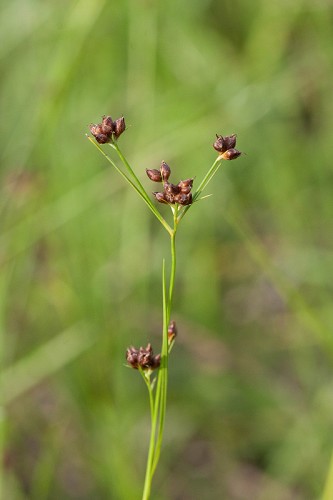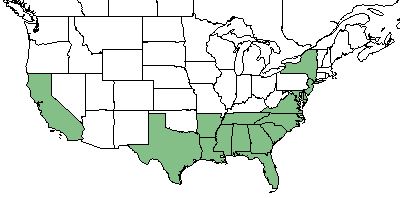Rhynchospora globularis
| Rhynchospora globularis | |
|---|---|

| |
| Photo by John Gwaltney hosted at Southeastern Flora.com | |
| Scientific classification | |
| Kingdom: | Plantae |
| Division: | Magnoliophyta - Flowering plants |
| Class: | Liliopsida – Monocotyledons |
| Order: | Poales |
| Family: | Cyperaceae |
| Genus: | Rhynchospora |
| Species: | R. globularis |
| Binomial name | |
| Rhynchospora globularis Chapm. Small | |

| |
| Natural range of Rhynchospora globularis from USDA NRCS Plants Database. | |
Contents
Taxonomic Notes
Synonym: none
Variety: Rh. globularis var. globularis GW
Description
R. globularis is a annual/perennial graminoid of the Cyperaceae family that is native to North America.[1]
Distribution
Found largely throughout the southeastern United States, R. globularis is specifically in Florida, Georgia, South Carolina, North Carolina, Virginia, Maryland, New Jersey, New York, Tennessee, Alabama, Mississippi, Louisiana, Texas, Arkansas, as well as in the western state California.[1]
Ecology
Habitat
R. globularis has been found in marsh shorelines, hardwood hammocks, ditches, prairies, cypress domes, scrub oak sand ridges, savannahs, floodplains, wetlands, and pine flatwoods.[2] It is also found in disturbed areas including logging road margins, along roadsides, pond trails, grassy pastures, and railroad ditches. [2]
Associated species: R. chapmanii, Senecio anonymus, Hedeoma hispida, Rhynchospora globularis, Polygala, Rhexia, Xyris, Scleria, and Sarracenia, Ilex, Myrica, Nyssa, and Rhynchospora spp..[2]
Additionally, it is an indicator species for the Calcareous Savannas community type as described in Carr et al. (2010).[3]
Phenology
R. globularis has been observed flowering in January and March through September with peak inflorescence in May.[4]
Seed dispersal
This species is thought to be dispersed by consumption by vertebrates.[5]
Fire ecology
Populations of Rhynchospora globularis have been known to persist through repeated annual burning.[6]
Conservation, cultivation, and restoration
R. globularis is classified as endangered in Maryland, Michigan, New Jersey, Ohio, and is of special concern in Kentucky.[1]
Cultural use
Photo Gallery
References and notes
- ↑ 1.0 1.1 1.2 USDA Plant Database
- ↑ 2.0 2.1 2.2 Florida State University Herbarium Database. URL: http://herbarium.bio.fsu.edu. Last accessed: June 2021. Collectors: Loran C. Anderson, Leonard J. Brass, George R. Cooley, R. J. Eaton, Robert K. Godfrey, Mabel Kral, R. Kral, John B. Nelson, C. E. Smith, D. B. Ward, E. West, A. A. Will. States and counties: Florida: Bay, Calhoun, Citrus, Collier, Franklin, Gilchrist, Gulf, Hernando, Lee, Levy, Martin, Pinellas, Santa Rosa, and Wakulla.
- ↑ Carr, S.C., K.M. Robertson, and R.K. Peet. 2010. A vegetation classification of fire-dependent pinelands of Florida. Castanea 75:153-189.
- ↑ Nelson, G. PanFlora: Plant data for the eastern United States with emphasis on the Southeastern Coastal Plains, Florida, and the Florida Panhandle. www.gilnelson.com/PanFlora/ Accessed: 29 MAY 2018
- ↑ Kirkman, L. Katherine. Unpublished database of seed dispersal mode of plants found in Coastal Plain longleaf pine-grasslands of the Jones Ecological Research Center, Georgia.
- ↑ Platt, W.J., R. Carter, G. Nelson, W. Baker, S. Hermann, J. Kane, L. Anderson, M. Smith, K. Robertson. 2021. Unpublished species list of Wade Tract old-growth longleaf pine savanna, Thomasville, Georgia.